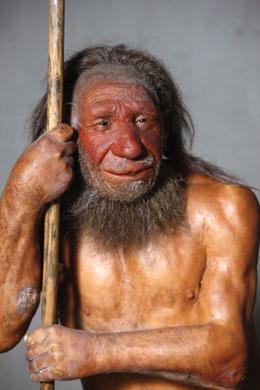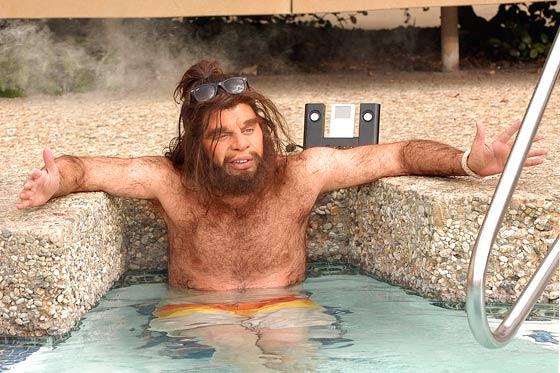
Posted on 06/03/2010 7:32:55 PM PDT by SeekAndFind
It was 15 months ago that Science carried a story about the completion of a rough draft of the Neandertal genome. Palaeogeneticist Svante Paabo of the Max Planck Institute for Evolutionary Anthropology in Leipzig was reported as saying "he can't wait to finish crunching the sequence through their computers". It has been quite a long time coming, as it is more than a decade since Paabo first demonstrated it was possible to analyse Neandertal DNA sequences. Earlier reports suggested that Neandertals were sufficiently distinct from humans for them to be classified as a separate species of Homo. The draft genome has more than 3 billion nucleotides collected from three female Neandertals.
"By comparing this composite Neandertal genome with the complete genomes of five living humans from different parts of the world, the researchers found that both Europeans and Asians share 1% to 4% of their nuclear DNA with Neandertals. But Africans do not. This suggests that early modern humans interbred with Neandertals after moderns left Africa, but before they spread into Asia and Europe. The evidence showing interbreeding is "incontrovertible," says paleoanthropologist John Hawks of the University of Wisconsin, Madison, who was not involved in the work. "There's no other way you can explain this"."

Neanderthals once bred with Homo sapiens. (credit PHOTOLIBRARY, source here)
Genetically, then, Neandertals are not altogether extinct. Paabo is quoted as saying: "They live on in some of us". Therefore, the 'Out-of-Africa' model needs revision, as the migrants interbred to some extent with Neandertals and their genetic signatures spread through the migrant populations. According to Rex Dalton in Nature:
"That revelation is likely to revive the debate about whether or not the two groups are separate species, says anthropologist Fred Smith of Illinois State University in Normal, who has studied Neanderthals in Europe. Smith thinks that they are a subspecies of H. sapiens. Now that the genomes can be compared, it will be possible to investigate the genetic roots of some shared features."
This theme is picked up in the pages of New Scientist, and especially noteworthy is the editorial: "Welcome to the human family, Neanderthals". It calls for Neanderthals to be given a warm reception as truly human relatives.
"Svante Paabo, the pioneer of palaeogenetics, equivocated when a reporter asked whether his genome study suggested Neanderthals are the same species as us: "I would more see them as a form of humans that were a bit more different than people are from each other today, but not that much."
Why so shy? Putting aside the vexing question of what defines a species - which flummoxed even Linnaeus and Darwin - it is hard to see why Neanderthals should now be considered as anything other than Homo sapiens. We know that Neanderthals bred with our ancestors and produced fertile offspring, which is one hallmark of a species. And there is plenty more evidence to support giving them the status of Homo sapiens neanderthalis. Neanderthals shared a common ancestor with modern humans around 500,000 years ago. Its descendants went their separate ways as the Neanderthals adapted to colder climes, but then, at least 50,000 years ago, they resumed relations in the eastern Mediterranean, where the two populations met again. This pattern wouldn't necessarily merit separate species status for most animals, so why for us and Neanderthals?"
There is undoubtedly some journalistic enthusiasm here, because the claimed "hallmark of a species" is not valid: hybridisation is not that unusual between species and sometimes it occurs between genera (within the same family). This in itself is not a decisive argument. However, when we combine genetics, morphology and behaviour, the picture looks much clearer.
"There is, of course, more to the concept of being human than ecology and genetics: we are human because we think, talk, love and believe. It is impossible to know the mental life of a Neanderthal, but there is reason to think that it was not so different from our own. The Neanderthal genome differed little from ours, encoding fewer than 100 changes that would affect the shape of proteins. True, some of these differences occur in genes linked to brain function, but similar variation is found among humans today. Moreover, Neanderthals share with us a version of a gene linked to the evolution of speech, and recent archaeological evidence suggests that their minds were capable of the symbolic representations that underlie language and art. If that's not human, then what is?"
This brings us to why Neandertals have been so misinterpreted over the years. Why has it taken us so long to reject the picture of a brutish, grunting caveman devoid of aesthetics and reason? The Editorial starts with these words: "WE HUMANS like to see ourselves as special, at the very pinnacle of all life. That makes us keen to keep a safe distance between ourselves and related species that threaten our sense of uniqueness. Unfortunately, the evidence can sometimes make that difficult." Is this interpretation valid? Do we like to keep a safe distance between ourselves and anything that threatens our uniqueness? Perhaps we should reflect on on the history of scientific racialism, that portrayed races as occupying different rungs of the evolutionary ladder - was this also to keep a safe distance from races that threatened our uniqueness? Furthermore, is it true that we, the population at large, like to keep this safe distance? Why is it that any reports of animals showing apparent cognitive and creative skills are deemed newsworthy, whereas other studies showing a big divide between humans and animals languish in obscurity? I leave these questions for further thought and reflection.
One thing I have noticed over the years is that people with a design perspective have been far more receptive to the idea that Neandertals were part of the human family. They have been impressed by morphological considerations, but the cultural artifacts of Neandertals have made a big impression. In the early days, these were relatively meager, but more recent years have seen a flowering of reports of Neandertal culture. In this blog, these issues have been explored on several occasions: Burying the view that Neanderthals were half-wits, Darwinist thinking on the origin of religion, The cognitive skills of Stone Age Man, Images of evolution as secular icons, Walks like a man, talks like a man - is it a man?, and Rethinking Neanderthals. There is a pattern here, and it is evident even in the original reception given to Neandertal finds. The Darwinian scientists were looking for intermediates and they found one in Neandertal Man. He was portrayed as an ape-man and used to prop up an evolutionary story of ape-to-man evolution. After it was realised that the original finds were bones from someone deformed by disease, the story did not change much. The icon was too important to lose. Darwinism had created a blind spot for palaeoanthropologists and impaired the progress of science. Those able to make design inferences within science have been ahead of the game, but now the genetic data is published, all have to follow. However, would you believe, the same issue of New Scientist that carried the editorial noted above also had an article with the title: "Neanderthals not the only apes humans bred with". Apes? Really! Outdated traditions do not die when it comes to Darwinism - they just get repackaged!
A Draft Sequence of the Neandertal Genome
Richard E. Green [et al] and Svante Paabo
Science, 328, 7 May 2010: 710-722 | DOI: 10.1126/science.1188021
Abstract: Neandertals, the closest evolutionary relatives of present-day humans, lived in large parts of Europe and western Asia before disappearing 30,000 years ago. We present a draft sequence of the Neandertal genome composed of more than 4 billion nucleotides from three individuals. Comparisons of the Neandertal genome to the genomes of five present-day humans from different parts of the world identify a number of genomic regions that may have been affected by positive selection in ancestral modern humans, including genes involved in metabolism and in cognitive and skeletal development. We show that Neandertals shared more genetic variants with present-day humans in Eurasia than with present-day humans in sub-Saharan Africa, suggesting that gene flow from Neandertals into the ancestors of non-Africans occurred before the divergence of Eurasian groups from each other.
See also:
Dalton, R., Ancient DNA set to rewrite human history, Nature, 465, 148-149, (12 May 2010) | doi:10.1038/465148a
Editorial, Welcome to the human family, Neanderthals, (New Scientist, 12 May 2010)
Gibbons, A., Close Encounters of the Prehistoric Kind, Science 328, 7 May 2010: 680-684.
Just look at first woonkie
We only had a few drinks.

Hey man, its all good.
nyaaah nyaaaah, we yec’s were there first....
The pic looks like Mel Brooks

RE: I think they meant “Neanderthals are part of the first family.”
1)Well, what can I say ? The evidence went from “slam dunk” similarity between Chimps and Humans, to almost a complete turnaround to their being growing compelling evidence for individuality of genomes. I hope people will understand my reservations with this Neanderthal study a little more clearly now.
2) If one were to read Young Earth sites like Answers In Genesis and Institute for Creation Research, one would learn that have been saying for decades that Neanderthals were normal human beings with Rickets disease and existed as separate colonies from humans, much like leper colonies.
What about democrats?
It also made it clear that they were probably still around and well mixed into the European peoples.
Red/Yellow pigment is still rare among East Asians, and although they have lighter skin tones than more Tropical peoples, it's through an entirely different set of changes than those of the Europeans
All things considered it's entirely possible that the Europeans have more Neanderthal background than they do recent African background.
This would divide humanity into two current major strains ~ Africans, and Neanderthals, with blends existing elsewhere, e.g. in Eastasia.
This is not an original idea ~ more or less the way paleontologists were looking at things up to as recently as 1970.
Just in the brother-in-law ranks though, for some curious reason.
/johnny
/johnny
Prime example lives in the White House
There is no explanation for them. Some things are too irrational for any accounting.
The IPCC's reliance on Hasnain's 1999 interview with NS has was highlighted by Fred Pearce, the journalist who carried out the original interview for the New Scientist-World misled over Himalayan glacier meltdown.
Rickets. LOL. Yeah. Like leper colonies. In the stone age. With dinosaurs presumably?
According to both morphology and DNA, neanderthals are distinctly not homo sapiens.
The Neanderthals are exceedingly closely related to Europeans and Eastasians.

Disclaimer: Opinions posted on Free Republic are those of the individual posters and do not necessarily represent the opinion of Free Republic or its management. All materials posted herein are protected by copyright law and the exemption for fair use of copyrighted works.